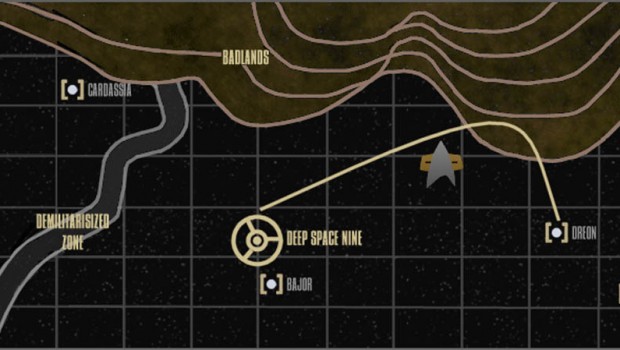Lomales: A Hitch in Federation-Laudean Relations?
Could the treatment of Lomales prove a stumbling block on the road to Federation membership? FNS guest contributor Doctor Saveron reports on the controversial issue.
Til’ahn – or Duronis II as it is known to non-Laudeans – is home to one of the Federation’s most intriguing neighbours. Outwardly similar to many humanoid species, the Laudeans possess some rare features: their fielding ability which allows them to detect energy fields, and their three-gendered mode of reproduction. Unfortunately the latter may prove problematical should the Laudeans ever choose to seek Federation membership.
 It is not the nature of the Laudeans’ reproduction that is the sticking point, rather their treatment of their third gender, the Lomale. Comprising only 3% of the population, the Lomale is necessary for a couple to reproduce, and where male and female Laudeans are monogamous, Lomales are expected to be promiscuous and move from couple to couple. During the invasion of Duronis II by the Romulans, Lomales were kidnapped and their movements controlled by the invaders, severely reducing the native populations, a setback from which the Laudean people had not yet fully recovered. However, once free of the Romulans, the covens have largely taken over control of the Lomales’ activities, leaving this reporter to ask how much has truly changed?
It is not the nature of the Laudeans’ reproduction that is the sticking point, rather their treatment of their third gender, the Lomale. Comprising only 3% of the population, the Lomale is necessary for a couple to reproduce, and where male and female Laudeans are monogamous, Lomales are expected to be promiscuous and move from couple to couple. During the invasion of Duronis II by the Romulans, Lomales were kidnapped and their movements controlled by the invaders, severely reducing the native populations, a setback from which the Laudean people had not yet fully recovered. However, once free of the Romulans, the covens have largely taken over control of the Lomales’ activities, leaving this reporter to ask how much has truly changed?
To understand Laudean society you need to understand the covens and the importance of the fielding ability. A strong ability carries with it great prestige, and so whilst ostensibly lacking a caste system, standing in Laudean society is never the less in part dictated by the strength of an individual as a fielder. The covens are groups of strong fielders whose influence on society and its governance is both widespread and difficult to pin down, the organisations themselves having an unusual nature, somewhere between a religious organisation and a secret society, and their doings are not entirely transparent. One thing that is known is that they govern the activities of the Lomales, dictating whom they go to and when.
The Laudeans are not the first people with this tri-gendered system that the Federation has encountered. The Vissians also possess a third sex, known as a ‘cogenitor’, which like the Laudeans accounts for about 3% of the population. However the Vissians treated their cogenitors effectively as slaves, trading them between couples seeking to conceive and keeping them ignorant. How much is the Lomale situation similar to that of the cogenitor?
Whilst their liaisons are largely controlled by the Covens, Lomales are otherwise educated and participate fully in society. Like males and females they possess the fielding ability to a greater or lesser extent, and indeed it is popular folklore that a Lomale who is a strong fielding will engender children with strong abilities. Thus Lomales with strong abilities are much sought after, whilst those with weaker abilities are considered much less desirable.
The lot of the Lomale has changed greatly throughout Laudean history and between different Laudean cultures. From virtual slavery on one continent to celebrity visitor on another in ancient times, from a part of the wider community to secretive subset. In the upper echelons of society during renaissance times the luring of a Lomale partner was very much a game of politics, influence and seduction. Very recently of course Lomales were abducted and enslaved by the Romulans, hoping to engender Romulans with fielding abilities.
As Laudean society recovers from the Romulan invasion, contact with other species and the new ideas that brings may cause a shift in attitudes and ultimately change – again – the lot of the Lomale. Certainly new avenues have been opened, Starfleet now counts a Lomale Ensign amongst it’s Laudean officers. How Laudean society’s views will change – and in what direction – following exposure to the wider galaxy remains to be seen. It will be watched with interest by the staff of the Embassy on Duronis II, as are all developments on the world locally called Til’ahn. Rear Admiral Toni Turner’s staff will no doubt continue to represent the ideals of the Federation to those interested, whilst respecting the native cultures of the world on which they are guests, and providing information to the Federation on our neighbours, and potential new allies. We seem to have much in common, but it is those areas on which we vary that could be cause for future concern. Much is still unknown about the Laudeans themselves and that mysterious group, the Lomales.
How the Laudeans treat this extremely important minority group within their population could well dictate the result of any future application for Federation membership.


 Previous Article
Previous Article Next Article
Next Article Behind the Scenes at FNS: Office Oddities, Tribbles, and a Cat
Behind the Scenes at FNS: Office Oddities, Tribbles, and a Cat  A Retrospective on the Maquis
A Retrospective on the Maquis  The Shoals 3GN – everything we know so far
The Shoals 3GN – everything we know so far  Starfleet Science Opens New Academy Near Cardassian DMZ
Starfleet Science Opens New Academy Near Cardassian DMZ  Joint Starfleet-Intaran base begins operations
Joint Starfleet-Intaran base begins operations  Earth wins Fedevision Song Contest 2399
Earth wins Fedevision Song Contest 2399  End Program: Life Outside the Grid
End Program: Life Outside the Grid  Scientists’ Good Intentions Spawn Unforeseen Megadisaster
Scientists’ Good Intentions Spawn Unforeseen Megadisaster